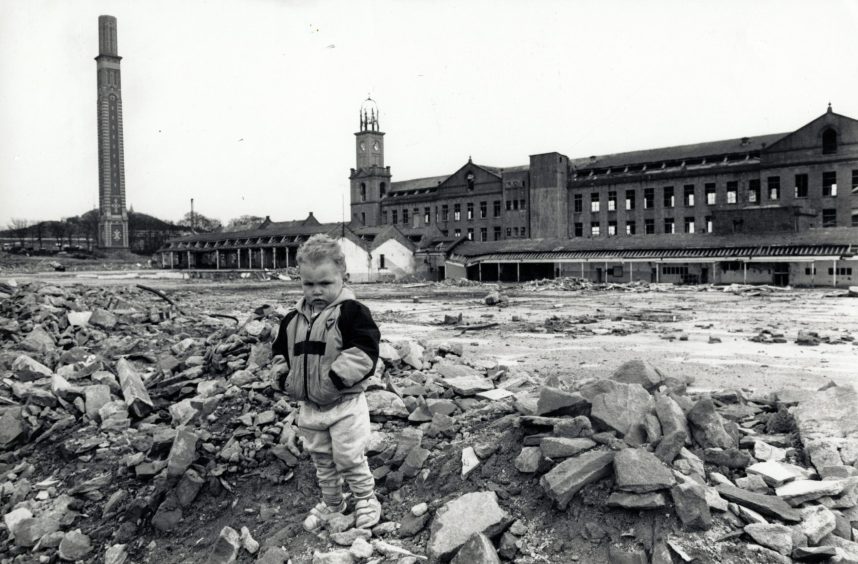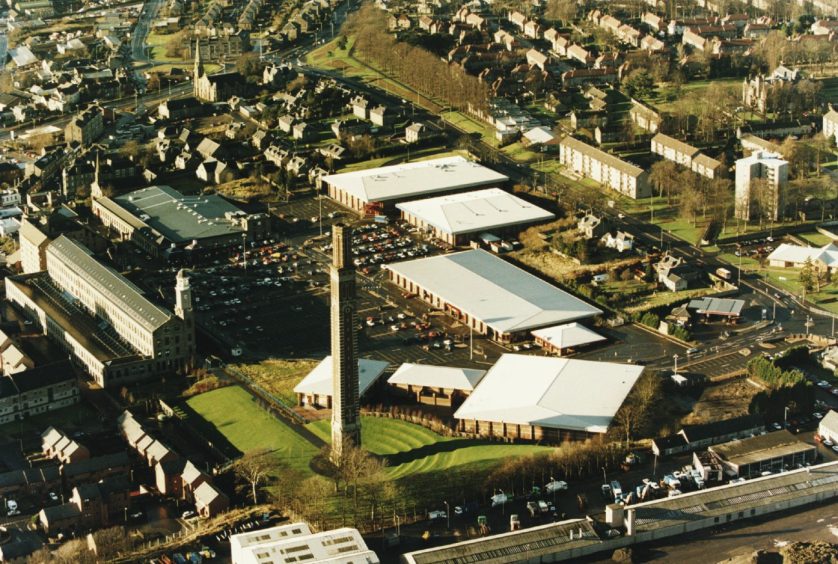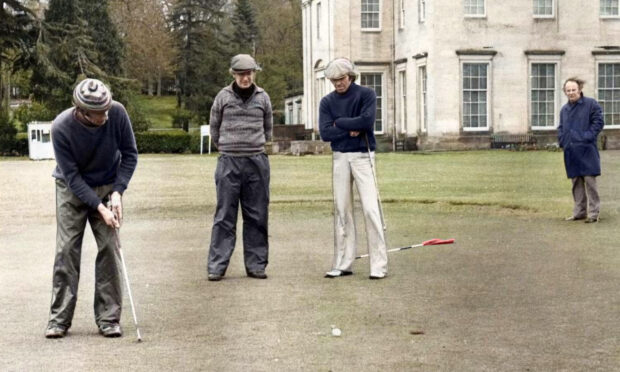
How would Lochee look without Cox’s Stack?
The 282-foot chimney was almost wiped off the map 40 years ago.
Cox’s Stack was built in 1866 and reputedly contained a million bricks.
The red and white brick chimney was the landmark for Camperdown Works in Lochee.
For 130 years the Camperdown complex, at one time sprawling over more than 25 acres, was the industrial giant of the suburb.
The closure in 1981 marked the end of an era for Dundee’s jute empire.
Barratt Homes agreed to buy Camperdown Works from Sidlaw Industries in 1982 for a £10 million housing development with 1,000 houses.
Dundee District Council chief planning officer Alistair Barrie confirmed it was the intention of the developers to demolish Cox’s Stack.
He stressed that many stages had to be passed before that happened.
Scottish Secretary would decide chimney’s fate
Mr Barrie said he believed the reasons for wishing to demolish the B-listed stack included a concern to prevent any danger to buildings around it.
“It might deteriorate in time,” he said.
“There would then be the possibility of bits falling off.”
The People’s Journal suggested “momentous days could lie just around the corner”.
“The important thing with such a major site in the very heart of Lochee is that the council get it right,” it said.
“It’s far too important an area to develop in a haphazard fashion.
“Include in ‘correct decision making’ the future of that giant mill chimney, Lochee’s best-known landmark – Cox’s Stack.
“How would Lochee-ites of today, never mind the old-timers, react to the stack’s demolition?
“It is, after all, thought important enough to carry listed building status and is a shining example of the Victorian grand style.
“The stack is visible even from the top of Ben Lawers – and that’s some 60 miles away!
“Lochee, mind you, has had to get used to the idea of change in recent times.
“The redevelopment of West High Street and the building of the by-pass changed the suburb‘s profile just as much as the high-rise blocks now familiar on the South Road.”
The planning process was long and drawn out.
Dundee District Council granted warrants for the demolition of Camperdown Works in July 1984, including Cox’s Stack and the spinning mill.
Provost Tom McDonald said Scottish Secretary George Younger would ultimately decide the fate of Cox’s Stack.
Stack was saved from wrecking ball
There was a public outcry.
Barratt Homes technical director Gordon Millar said his office had received a “welter of correspondence” on the fate of the prominent landmark.
Fate intervened.
Cox’s Stack was given a stay of execution in January 1985.
The housing plans were shelved and would be delayed by several months.
Barratt Homes said engineers discovered “major structural problems” and blamed the underground tunnels which fed the chimney from 58 furnaces.
Managing director George McLean said there would be a “major rethink”.
“We had expected some problems of this nature, but after the engineers had carried out the survey, what we have found is quite horrific,” he said.
“Many of these tunnels are in a bad condition and there’s no way we could build on top of that sort of arrangement.
“The whole lot will have to be dug up and levelled.
“None of the work is impossible and it’s our intention to proceed but it will be a while before we can begin to think about submitting detailed plans to the council.”
And then?
Nothing.
The housing development appeared to be quietly forgotten about.
Successive applications were rejected
Sidlaw Industries sold Camperdown Works to Dinnington Demolition and Developments Ltd from Nottinghamshire for £200,000 in 1985.
Dinnington began negotiations with Flame Lodge Ltd, which submitted a planning application for a £15m housing and retail development in July 1986.
Flame Lodge Ltd said the underground tunnels were filled in by Dinnington.
The plan included a museum in the shadow of Cox’s Stack.
The Courier said: “Now that the latest proposals for the Camperdown Works site in Lochee retain the famous Cox’s Stack, an imaginative and distinctive development is possible.
“The tall chimney makes an easy landmark for anyone in future seeking an address at Cox’s Stack Gardens or Camperdown Mill Terrace.
“It is to be hoped that a suitable role can be found also for the mill building and clock tower, which it is also intended to retain in the new plans.
“With nearly all signs of the jute industry in Dundee either demolished or transformed into flats, Cox’s Stack will remain to remind the new generations that jute supported the whole city for over a century.”
In September 1986 the Co-op lodged a planning application for a shopping centre, 300 flats and a sports hall.
Cox’s Stack was retained in the design.
The successive planning applications were rejected by the council because the shopping proposals might jeopardise existing retail outlets in Lochee.
Liz Hurley arrived at Cox’s Stack in 1988
Camperdown Works lay in ruins for most of the decade.
The BBC used the site in February 1988 to double for a bombed-out wartime Berlin.
The mini-series Christabel featured Liz Hurley in one of her earliest roles.
Dudhope Properties bought the site from Flame Lodge Ltd for £390,000 in April 1988.
The firm put forward £20m proposals which included private housing, a 45,000 square foot supermarket, leisure centre, ice rink, swimming pool and gardens.
The development plan was rejected by Dundee District Council in June 1989.
The main stumbling block was the retail development.
Dudhope Properties appealed the decision to Scottish Secretary Malcolm Rifkind.
Then they sold up.
Dundee man Michael Johnston bought the site.
He succeeded where others had failed with approval for a William Low supermarket in December 1990.
Johnston transformed the site into the Stack Leisure Park.
And he wanted everyone to know.
From Las Vegas to Lochee High Street
Cox’s Stack almost ended up with a £2.2m neon sign above it that would have made the landmark “visible from hilltops more than 40 miles away”.
Johnston wanted to import the advertising sign from America at a cost of £1.63 million.
It would have cost a further £600,000 to install on the listed chimney.
Income from the adverts would have paid for any preservation work on Cox’s Stack.
Planning permission for the advertising sign was first refused in August 1991.
Local councillors said it would “challenge the dignity of the chimney”.
Johnston appealed against the decision.
The situation was passed to the Scottish Office for final deliberations.
Historic Scotland turned down the appeal in March 1994.
The Stack Leisure Park at its height boasted the Odeon cinema, the Megabowl, Venue nightclub, Buzz Bar pub, Fatty Arbuckle’s restaurant and a bingo hall.
But the developer’s vision of creating a lively, bustling centre for entertainment and dining quickly proved to be a pipe dream as business after business shut its doors.
The leisure park has undergone something of a rebirth in recent years.
Some things have remained a constant, though.
Cox’s Stack has stood tall no matter how much things change elsewhere.



















Conversation